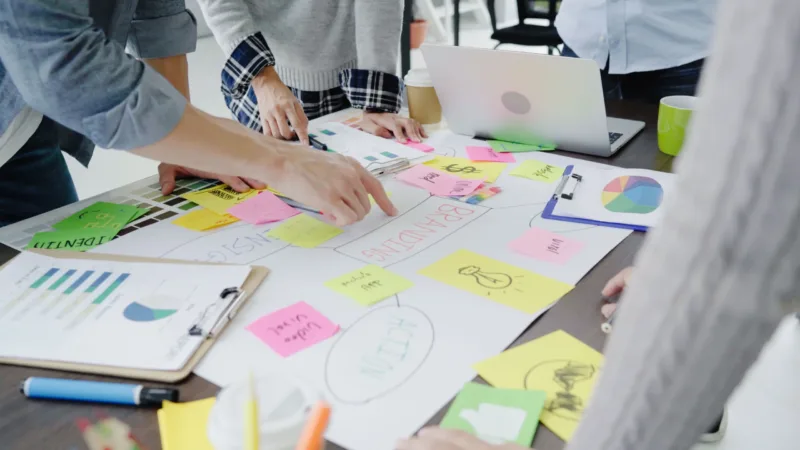So you’re ready to innovate. You want to change the way your firm interacts with clients and conducts business. You want to stand out from your competitors and become the firm your clients love.
First, you’ll need some insight. Then you might have an idea. Next it will be time to create a solution and test it out. Finally, when you know it’s a success, you’ll want to roll it out across your firm. But how do you get from point A to point B?
One avenue might be design thinking. This process creates a framework to help you gain deep insights into your clients’ needs, come up with out-of-the-box ideas, and create impactful solutions that drive real results for your clients and your firm.
For more perspectives on creative thinking, read our white paper, “How law firms can use creative thinking to drive a successful practice.”
Let’s talk about the five primary steps in the process.
1. Empathize
The first step in design thinking is about putting yourself in the shoes of the people you’re designing for. Go beyond what you think you know about your clients. Try to set aside your assumptions and approach the task as if you’re learning about them for the first time. Make a real attempt to see things from their perspective. Some common tactics include:
- Observation – Go where your clients are and see what they care about.
- Qualitative interviews – Set up one-on-one or small group interviews to ask questions about the challenge you’re addressing. Interviews are great opportunities for people to share stories that can highlight details you might not have considered.
- Immersion – Perform the tasks your clients do when they interact with your firm. Make a phone call, log in to the client portal, ask for the status on a document.
Once you’ve done this work, try using a tool like an empathy map to consolidate information. This exercise captures what your subjects said, did, thought, and felt about the challenge. It helps to limit bias and frame the conversation in their words rather than yours.
2. Define
This step is about stating your clients’ needs and problems. Take the time to talk about your findings from the first step. Narrow down the issues to a single problem statement.
A good problem statement has three characteristics:
- It is human-centered – Rather than framing the statement in terms of money saved or growth in a book of business, consider the people you are trying to help. For example, a bad problem statement might set a goal of increasing revenue by 5%. A human-centered goal would be to help clients get easier access to their documents.
- It is broad enough for creative freedom – Ensure the problem statement isn’t focused on a specific method for solving the problem. Do not list technical requirements. The team needs freedom to explore approaches that might bring unexpected value to the project.
- It is specific enough to make it manageable – A problem statement like “Reimagine the way our clients engage with us” is too broad to be meaningful and won’t yield impactful results. Focus on a specific problem that the team can reasonably address.
Experts note that it can be helpful to begin problem statements with a verb such as “create,” “define,” or “adapt” to make the problem action-oriented.
3. Ideate
Armed with empathy and a problem statement, now is the time for the team to start brainstorming ideas. It’s important in this step to separate idea generation from idea evaluation. You want your team to feel free to toss out any unusual or out-of-the-box ideas without fear of judgment.
In fact, make it a point to encourage team members to look for alternative ways to view the problem. Maybe the stated problem is being caused or exacerbated by something else that should be included in the solution. Maybe the “standard” solution to the problem is likely to cause more issues. The more diverse your ideas, the better chance you have of finding the right one.
Once you’ve collected the team’s ideas, then it’s time to move into the evaluation stage. Go around the room and ask clarifying questions, poke holes, and begin to separate the wheat from the chaff. It’s important to keep this activity collaborative so that the team (not an individual) chooses which ideas to prototype.
4. Prototype
The prototype phase is where things get exciting. Through trial and error, the team identifies which of the chosen solutions best solves the problem. Start with scaled-down versions of the products or services you envision. Quickly spinning up a simplified version allows you to get feedback from clients to inform new versions
Since you’ll likely have multiple ideas in play, low-fidelity versions reduce cost, risk, and time investments if they don’t work out. They also prevent you from over-investing in features that clients don’t want or need. You may be surprised how often clients are happy with the version of your idea that doesn’t include all the bells and whistles.
5. Test
Note that the final step in the process isn’t “deploy” or “release.” Design thinking asks you to take your prototypes to your clients for testing. You want this step to be as interactive as possible. You should ask:
- Does this solve the issue identified in the problem statement?
- What about the experience can be improved?
- What about the experience doesn’t need to be improved?
The goal here is to refine the prototypes to deliver the best possible solution. And that requires direct feedback from clients. Finally, it’s important to understand that this process is not linear. The steps we’ve discussed may happen in parallel or out of order. The point is to create a system that iterates until you’ve achieved a solution you and your clients are happy with. For more perspectives on creative approaches to problem-solving, download our white paper, How law firms can use creative thinking to drive a successful practice.







